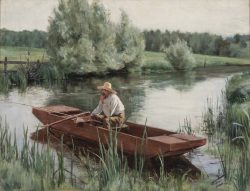E. J. Dressler 1859–1907
Edward James Dressler was born in the small southwestern Michigan town of Centreville. In Chicago he worked as a commercial engraver while attending the evening Life Class at the Art Institute of Chicago in 1892–1893. His teachers included Charles Edward Boutwood, whose summer landscape class Dressler joined in Delavan, Wisconsin, in 1893. Dressler became active in the Chicago Society of Artists and was among the organizers of a special benefit exhibition after the organization’s premises in the Athenaeum Building were gutted by fire in 1892.i Dressler traveled in the East and in 1894 contributed a pastel of Hudson River scenery to a charity sale of pictures held by the Chicago Society of Artists.ii Around that time he studied at the National Academy of Design in New York and joined the Salmagundi Club, a New York artists’ club, whose quarters served as his address when he made his debut in the Art Institute’s annual watercolor exhibition in 1895.iii
In 1897 Dressler exhibited paintings of pastoral Chicago-area scenes in the first of several well-received solo exhibitions at A. H. Abbott & Co., a local retailer of artists’ supplies.iv The Chicago Times-Herald reported that the artist “has literally thrown away his engraver’s tools, and he now devotes himself exclusively to painting.”v Dressler spent the following summer and autumn painting in Northern California.vi In San Francisco he exhibited his watercolors and he is said to have studied at the California School of Design and at the Mark Hopkins Institute of Art.vii His return in December was announced along with the news that he had taken up residence in Chicago’s new Tree Studios building on the Near North Side.viii Reviewing a showing of Dressler’s watercolor paintings of California subjects at Abbott’s in the spring of 1898, the Times-Herald proclaimed him “among the most accomplished landscapists of the west,” while acknowledging that he was comparatively little known, due to exhibiting infrequently.ix
Dressler visited Arizona and New Mexico in 1899 to paint and for a more healthful climate, likely because he was already suffering from the tuberculosis that would eventually take his life.x While away from Chicago, he had another highly praised exhibition at Abbott’s, and in September he served on the committee of artists advising the Art Institute’s jury for the annual exhibition of American art, evidently a mark of the respect in which he was held.xi In 1900, Dressler married fellow artist Bertha Menzler (later Bertha Peyton), then launching her own career as a painter of landscapes and still lifes, and he moved into her studio in the Fine Arts Building. Although Dressler exhibited actively that year and won a prize for his entry in the Chicago artists exhibition at the Art Institute, by October he had filed for bankruptcy.xii The Art Institute’s 1901 annual Chicago artists exhibition was the last recorded showing of his work. In 1903 the Dresslers visited Arizona, no doubt prompted by Edward’s poor health and in search of painting subjects for Bertha, who supported the couple during Edward’s final illness.xiii A University of Chicago professor who befriended the artist at that time praised his “master mind” and noted that he “was just coming into his own as an artist in public recognition” when his health failed.xiv
Wendy Greenhouse, PhD
i “Everything Lost but Courage,” Chicago Tribune, Apr. 28, 1892.
ii “’Charity Sale’ of Pictures Begins,” Chicago Tribune, Jan. 17, 1894.
iii Dressler’s address was the Salmagundi Club when he exhibited at the Art Institute in 1895; see also W. H. Shelton, The Salmagundi Club, Being a History of Its Beginning as a Sketch Class, its Public Service as the Black and White Society, and its Career as a Club from MDCCCLXXI to MCMXVIII (Boston and New York: Houghton Mifflin Co., 1918), 70-71.
iv “Art and Artists,” Chicago Post, May 15, 1897; Untitled clipping, Chicago Inter Ocean, May 16, 1897, in AIC Scrapbooks, vol. 8, 127; untitled clipping, Chicago Times-Herald, May 23, 1897, in AIC Scrapbooks, vol. 8, 130; “Art,” Chicago Tribune, May 23, 1897.
v Untitled clipping, Chicago Times-Herald, May 23, 1897, in AIC Scrapbooks, vol. 8, 130.
vi “Art and Artists,” Chicago Post, May 15, 1897, in AIC Scrapbooks, vol. 8, 125; “Art,” Chicago Tribune, Dec. 26, 1897.
vii On Dressler’s studies in San Francisco, see Who Was Who in American Art, vol. 1, 961, and askart.com; on his solo exhibition in San Francisco, see “Art,” Chicago Tribune, Dec. 26, 1897. Dressler’s enrollment at the California School of Design at the Mark Hopkins Institute of Art cannot be verified, as enrollment records for this period are unavailable. See email from Julian Wong-Nelson, Apr. 3, 2018, in Dressler file.
viii “Art,” Chicago Tribune, Dec. 26, 1897.
ix Untitled clipping, Chicago Times-Herald, Apr. 10, 1897, in AIC Scrapbooks, vol. 8.
x “Art,” Chicago Tribune, Jan. 15, 1899.
xi “Art and Artists,” Chicago Post, Mar. 11, 1899; “Art,” Chicago Times-Herald, Mar. 19, 1899.
xii News of the Courts,” Chicago Tribune, Oct. 25, 1900; see also “Express Driver Says He Stole,” Chicago Tribune, Feb. 12, 1901.
xiii “Artist Ill but Turned Out,” Chicago Tribune, Nov. 25, 1907.
xiv Prof. William C. Wilkinson quoted in “Artist Ill but Turned Out,” Chicago Tribune, Nov. 25, 1907.
